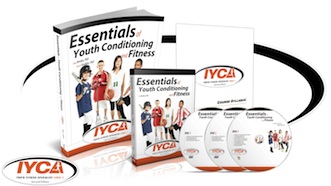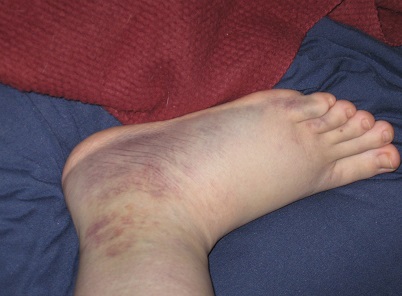A Complete Progression for All Athletes Who Want Power and Success
If you have been following the IYCA and those that contribute to their content, you have probably heard the training philosophy: 2 pulls for every 1 push.
 While I agree that pulling strength is incredibly important, I think it’s necessary to step back and understand what a stronger backside can do for an athlete.
While I agree that pulling strength is incredibly important, I think it’s necessary to step back and understand what a stronger backside can do for an athlete.
First and foremost, just like their adult “desk jockey” counterparts, young athletes sit ALL DAY LONG. Combine that with heavy backpacks, phones and tablets—we know that their posture sucks!
Activating and strengthening the over-lengthened posterior chain muscles (lats, glutes, hamstrings, etc.) via pulling exercises will counteract the effects of teenage living, at least briefly.
Pro Tip: A much more important reason for an athlete to train the posterior chain, is the ability to push. Yes, you read that correctly, PUSH!
Look at most of the texts with a training program for athletes. You are much more likely to find Bench, Squat, Deadlift, Military Press or Strict Overhead Press than you will Chin-ups or Rows.
First of all, the Press, Overhead or Bench tends to elicit more total body activation.
Since pushing or pressing is much more common athletically than pulling is, pulling movements take an accessory role compared to pressing movements.
If you have ever taken a group of young athletes through the shoulder mobility screen via FMS, you will see a majority that have fantastic mobility but massive winging and an overextended rib cage. These factors, if ignored, could have terrible consequences for an athlete that is thrown directly into overhead pressing.
Given the proper progressions for vertical pulling and building the musculature around the scapula, an athlete will be set up for success in overhead pressing patterns.
To develop a strong, athletic press for athletes, they need to progress through vertical pulling progressions!
Progressions
Half Kneeling Single Arm Resistance Band Rows
This is usually the most confusing exercise for our athletes when they see their first program because we don’t have a cool or creative name for it. Therefore, it looks like this:
HK SA RB Rows…Yikes!
Two things are happening here:
- The athlete is learning half kneeling, thereby, glute activation/hip flexor lengthening tied into a rowing pattern—reversing postures experienced all day in a classroom.
- By doing a single arm row, the athlete can “feel” what it is like to actually move the scapula around the rib cage rather than shooting it straight back.
Notice this is NOT a vertical pull. Oftentimes, starting an athlete with a vertical pull will end in overextending the ribs, and never activate musculature to develop strength for more advanced progressions.
Pro Tip: The best cues here are simply ribs down, reach, then pull the blade into the opposite back pocket. Sometimes, it’s helpful to kinesthetically guide the athlete’s scapula through the movement after they have tried a few times themselves.
Jungle Gym Rows
We call them Jungle Gym Rows because that is the brand of suspension straps we have. Obviously most people know them as TRX rows. This is my favorite progression for upper body pulling and will likely be revisited throughout an athlete’s annual training program.
However, throughout my 10+ years as a coach/trainer, I have seen this exercise butchered much more than I have seen it done correctly.
It starts by having the athlete plank their body (legs, butt, & core active to make a straight board with their body—a plank!). Then, they need to “reach”, followed by bringing their elbows behind them.
One mistake we see is the athlete shrugging their shoulders up to make up for a weak upper back. The cue we use to eliminate that is, “shoulders away from the ears.”
The movement ends when the chest is broad and the back is extremely active.
Early on, correct athletes and have them stop short of what they think is end range. If you don’t, they will keep pulling—since it gets easier—and roll their shoulders forward, losing the upper back engagement.
Seated Lat Pulldown
Here is the first exposure our athletes have to a vertical pulling pattern. They must establish great positioning before moving on to the most demanding progressions, which is why using the seated version is the first choice.
Pro Tip: Our gym does not have a cable machine so we use resistance bands. However, if you do have a cable machine, I would still suggest having your athletes use it while sitting on the floor straight legged.
If necessary, you can put something under their pelvis, like a yoga block, to create neutral positioning of the spine during the movement.
Once they are in position, the cues are the same: “ribs down, reach, then pull the blades into the back pockets.”
This should result in a very vertical movement. The hands should come down right on top of the medial shoulder. The tendency is to overuse the anterior delts and pecs, and bring the shoulders together to achieve full range under fatigue.
Coach the athlete to keep the chest and shoulders broad, and stop before the upper body rounds to try and finish the set. The end range position looks and feels quite similar to the Jungle Gym Row, except the hands are on top of the shoulders rather than closer to the armpits.
Quality always trumps quantity here, so educate your athletes that it’s not worth it to grind out reps when their form stinks.
Recover and finish the set correctly.
Chin-ups/Pull-ups
Our athletes love their chin-up/pull-up days…sarcasm is hard to convey in text, but they usually don’t like chin-up/pull-up days.
That is, of course, until about junior or senior year of high school. Once they have developed the strength and worked through all the progressions, they notice that they have a stronger back and shoulders than all their friends. Then, chin-ups are the BEST! 🙂
Start teaching the pattern to athletes early. Despite a lack of strength, it develops potential for massive back, arm and grip strength. These are traits that assist greatly in the ability to press, and also make a better transition from middle school to high school sports or JV to Varsity.
Grip strength, is an undervalued asset that comes in handy when everyone is bigger than you and thinks they are stronger than you. If you can hold onto the ball or the stick and handle yourself, you gain respect from your older teammates and develop confidence.
Pro Tip: Start athletes using a band for assistance to learn a proper, vertical path for the chin-up or pull-up.
Form checks are critical early on as they often have done body weight movements like this before.
If we don’t correct them right away, we will have to backtrack later on. The same thing goes for push-ups, which you can read more about in my Pushing Power in Athletics Blog.
Don’t let an athlete do 6 chin-ups the wrong way and then correct their form only to achieve 3 the next time. That kills their confidence.
Focus the cues on pulling the blades into the back pockets and keeping the chest/shoulders broad, reinforcing the carry over from the lat pulldown to the chin-ups. It’s great to break a set up into increments early on.
Pro Example: If we want 24 reps of work, instead of doing 3 sets of 8 reps, we would write it in their program as 3 sets of 2 reps 4x. When we coach it, we would explain it as, “do 2 reps perfectly and aggressively, then rest 20 seconds and repeat with the same perfection and aggression.”
They won’t always achieve perfect reps but the quality of the entire set and the 24 total reps they do will improve dramatically.
Wrapping it up
Pulling exercises for an athlete are incredibly important.
I hope you now have a better understanding of WHY they are so important for young, developing athletes and how you can better utilize these progressions in your own training programs!
ADAPT and Conquer,
Coach Jared
About the Author: Jared Markiewicz
 Jared is founder of Functional Integrated Training (F.I.T.). F.I.T. is a performance-based training facility located in Madison, WI. They specialize in training athletes of all levels: everyday adults, competitive adults and youth ages 5-20+.
Jared is founder of Functional Integrated Training (F.I.T.). F.I.T. is a performance-based training facility located in Madison, WI. They specialize in training athletes of all levels: everyday adults, competitive adults and youth ages 5-20+.
The long-term vision for F.I.T. is recognition as the training facility for those desiring to compete at the collegiate level in the state of Wisconsin. Alongside that, to also develop a platform to educate those in our industry looking to make strides towards improving the future for our young athletes.
Find out more about Jared’s gym by visiting F.I.T.
Career Highlights
- 2014 Fitness Entrepreneur of the Year – Fitness Business Insiders
- 2014 IYCA Coach of the Year Finalist
- Volunteer Strength Coach for West Madison Boys Hockey and Westside Boys Lacrosse
- Helped develop dozens of scholarship athletes in 3 years of business
- Instructed Kinesiology Lab at UW-Madison
- Houses an internship program at F.I.T. that started in 2013
- Member of Elite Mastermind Group of Nationwide Fitness Business Owners
Generate Power in your Athletes with
Power Evolution
Discover, step-by-step, how to develop the most coveted trait possessed by the world’s most successful athletes.
















 Julie is the Executive Director of the International Youth Conditioning Association (IYCA). She grew up as an athlete and played collegiate softball at Juniata College. She currently owns and operates her own youth fitness business pouring into young athletes. Her areas of expertise are youth sport performance, youth fitness business and softball training/instruction. Julie grew up on a dairy farm and can challenge the best of the best in a cow-milking contest. 😉
Julie is the Executive Director of the International Youth Conditioning Association (IYCA). She grew up as an athlete and played collegiate softball at Juniata College. She currently owns and operates her own youth fitness business pouring into young athletes. Her areas of expertise are youth sport performance, youth fitness business and softball training/instruction. Julie grew up on a dairy farm and can challenge the best of the best in a cow-milking contest. 😉 








 Current and emerging research regarding early sport specialization versus long-term athletic development continues to support the IYCA’s stance that the long-term athletic development model, or LTAD, provides the greatest benefit to a developing athlete, in both physical and psychological aspects, over time.
Current and emerging research regarding early sport specialization versus long-term athletic development continues to support the IYCA’s stance that the long-term athletic development model, or LTAD, provides the greatest benefit to a developing athlete, in both physical and psychological aspects, over time.  The results, while consistent with the IYCA’s message since inception, further illustrate the tangible risks young athletes are exposed to when their parents, caregivers, and/or coaches ascribe to the early specialization model.
The results, while consistent with the IYCA’s message since inception, further illustrate the tangible risks young athletes are exposed to when their parents, caregivers, and/or coaches ascribe to the early specialization model. The study involved 154 participants (92 male, 62 female) with an average age of 13. All participants were scored using a six-point sport specialization score and other factors such as height and weight were recorded.
The study involved 154 participants (92 male, 62 female) with an average age of 13. All participants were scored using a six-point sport specialization score and other factors such as height and weight were recorded.  Dr. Toby Brooks is currently an Assistant Professor in the Master of Athletic Training Program at the Texas Tech University Health Science Center in Lubbock. Dr. Brooks has worked with numerous youth, collegiate, and professional athletes and previously owned and operated a youth athletic development business. He is also Co-Founder and Creative Director of NiTROHype Creative in Lubbock.
Dr. Toby Brooks is currently an Assistant Professor in the Master of Athletic Training Program at the Texas Tech University Health Science Center in Lubbock. Dr. Brooks has worked with numerous youth, collegiate, and professional athletes and previously owned and operated a youth athletic development business. He is also Co-Founder and Creative Director of NiTROHype Creative in Lubbock.